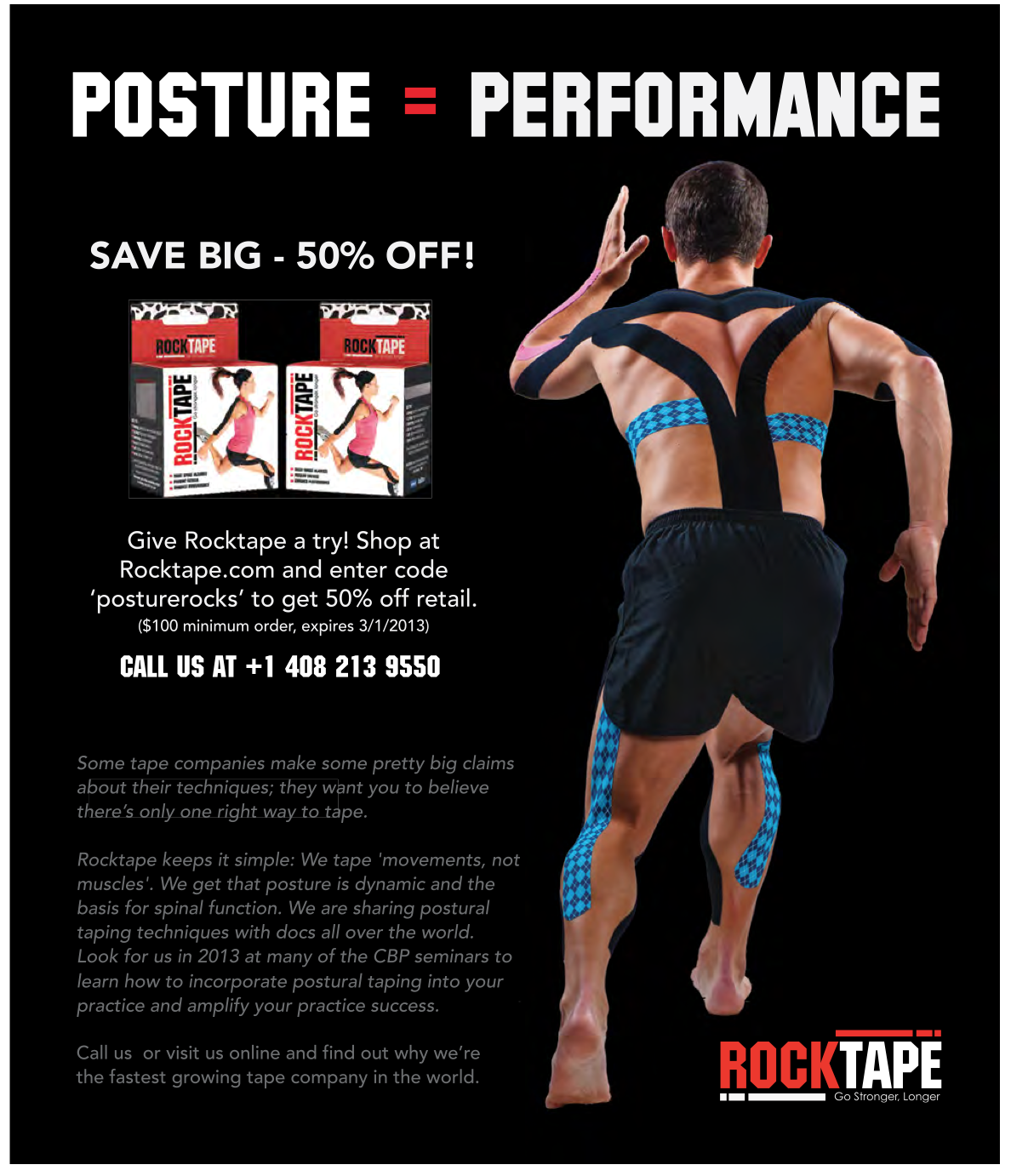Kinesiology Tape for Postural Control
 Sunday, January 20, 2013 at 11:57AM
Sunday, January 20, 2013 at 11:57AM  INTRODUCTION
INTRODUCTION
As chiropractors, sometimes our efforts become frustrating if our careful attention to adjusting, stretching and strengthening, is undermined by patients resuming the same postural flaws that landed them in our offices in the first place. How exciting would it be to have a sticky, stretchy little assistant that reminded our patients for 2-5 days about positional awareness? Enter elastic therapeutic tape!
By now, the vast majority of practitioners have had some exposure to elastic therapeutic tape or “kinesio-tape”, the commonly used brand name of developer Kenzo Kase. Tape companies claim it “reduces muscle soreness, improves function, decreases bruising, and decreases pain” and to some extent, these claims appear to be accurate.
Anything that touches our body’s biggest organ, the skin, has a cutaneous mechanoreceptor effect that stimulates receptors to enhance body kinesthesia or movement awareness. By stimulating large skin mechanoreceptors, kinesiology tape can also downgrade painful stimuli from the nociceptors, which decreases pain perception.
Early and persistent reasoning suggested that using the tape in an “origin to insertion”, or “muscle action” methodology, best serves to support/stimulate external body areas. While this approach probably makes the most intuitive sense to medical practitioners as it follows anatomical “rules of engagement”, emergent theories, which consider entire postural muscle groups, are making a strong case.
Dr. Steven Capobianco, chiropractor and developer of the Fascial Movement Taping (FMT) method argues, kinesiology taping should be “based on the obvious yet largely overlooked concept of muscles acting as a chain… the body’s integration of movement via multi-muscle contractions as a means of connecting the brain to the body’s uninterrupted fascial web in order to enhance rehab and athletic performance via cutaneous (skin) stimulation. By taping movement rather than muscles, FMT has demonstrated greater improvement in both patient care and sport performance.
Dr. Capobianco is not alone in this line of thinking. Leading fascia researcher, Robert Schleip PhD, underscores movement and its role in pain and dysfunction1. Additional support for this model comes from Thomas Myers in his ground-breaking book, “Anatomy Trains”2. He offers a template to assess, treat, and manage body-wide motor dysfunction based on myofascial meridians, and movement impairment.
Physical Therapy professor, Heather Murray, makes a strong case for the use of elastic therapeutic tape in those who maintain abnormal postures of the head and neck (i.e. in the work place). Her team conducted a pilot study3, which seemed to suggest that taping for scapular protraction could maintain better posture and decrease perception of pain.
Recent research indicates that kinesiology tape has a greater stimulatory effect with compromised tissue (due to injury or fatigue due to poor posture). Thedon, et al4 conducted a study to evaluate body sway in individuals with and without tape. They found that the tape showed very little change in the uncompromised condition, but when the subjects were fatigued, the tape provided an added stimulatory effect to the skin helping to compensate for the loss of information fed to the brain from the muscles and joints. For the pain and performance community, this study provides insight into an “auxiliary” system, such as the skin, to augment treatment and training outcomes.
A 2012 study5 of 32 surgeons, showed a statistically significant reduction in neck and low back pain (using Oswestry Low Back Disability Index and Neck Disability Index) and functional performance (using neck and low back range of motion scores) with the use of kinesiology tape during surgery. This may have far-reaching implications for other jobs/activities where sustained positions result in musculoskeletal pain.
Let’s look at a common complaint where chiropractors can utilize elastic therapeutic tape to enhance postural control (awareness). Kinesiology tape is commonly used in chiropractic offices to enhance scapular retraction, alleviating upper extremity discomfort caused by internally rotating shoulders (especially when the scapula is in a protracted position). The tape, according to Dr. Capobianco’s model, is applied in a functional manner to augment its therapeutic effect. Begin by addressing the neuro-myo-skeletal dysfunction associated with the protracted shoulder girdle (manipulation, myofascial release, movement re-patterning, etc.). Once the patient is able to appreciate an appropriate retracted/depressed scapula, apply the kinesiology tape (see inset) in a manner to, appropriately, stimulate the local receptors once the intended position is lost.
- Step 1: Manually mobilize/manipulate the thoracic spine and shoulder girdle and associated myofascial chains
- Step 2: Place patient/athlete into appropriate postural position that centrates the scapula-thoracic segment.
- Step 3: Tape the local area (see X pattern and H pattern) with “NO” stretch to stimulate local receptors
- Step 4: Corrective exercises that will help with postural re-education.

SUMMARY
Clearly the use of kinesiology tape is popular (millions of users) and the applications are broad (from athletic injuries to edema). Specific evidence for efficacy is scant but growing, and plausible. There are currently no reported dangers associated with using this elastic cotton mesh bandage, and the only significant contraindication is on open wounds. Kinesiology tape breathes well and flexes like a second skin, unlike most braces that act more like abrasive exoskeletons. It withstands sweat and/or water and is by most comparisons a cost-effective treatment modality. While science is unlikely to discover that kinesiology tape is the panacea for all aches, injuries and postural distortions, medical practitioners should keep this tool in the chest due to its vast possibilities in treating patient complaints and as a tool for postural re-education.
References:
1. Schleip R, Muller D. Training principles for fascial connective tissues: Scientific foundation and suggested practival applications. J Body Move Ther 2012;1-13.
2. Myers, T.W. 2009. Anatomy Trains: Myofascial Meridans for Manual and Movement Therapists. New York: Churchill-Livingston.
4. Thedon T, et al. Degraded postural performance after muscle fatigue compensated by skin stimulation. Gait Posture, 2011 Apr;33(4) 686–9.

 CBP Seminars | Comments Off |
CBP Seminars | Comments Off |  Chiropractic BioPhysics,
Chiropractic BioPhysics,  kinesiotaping,
kinesiotaping,  rocktape
rocktape 

